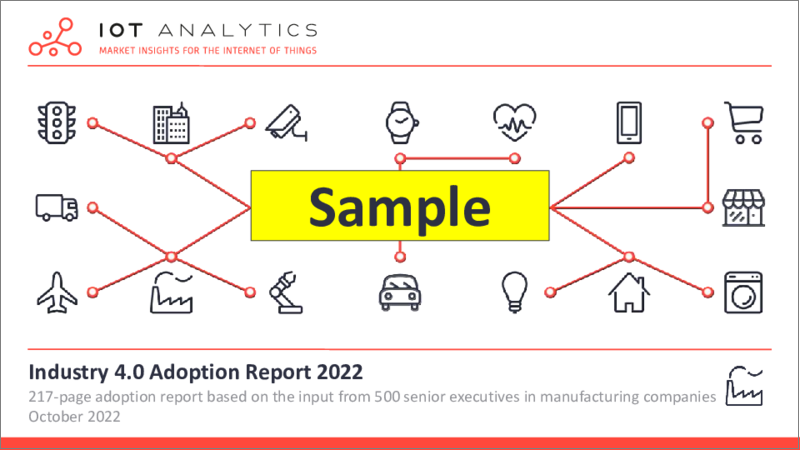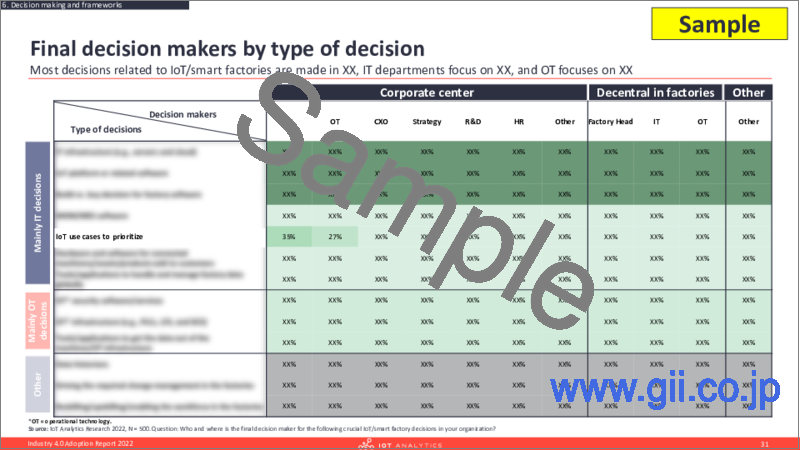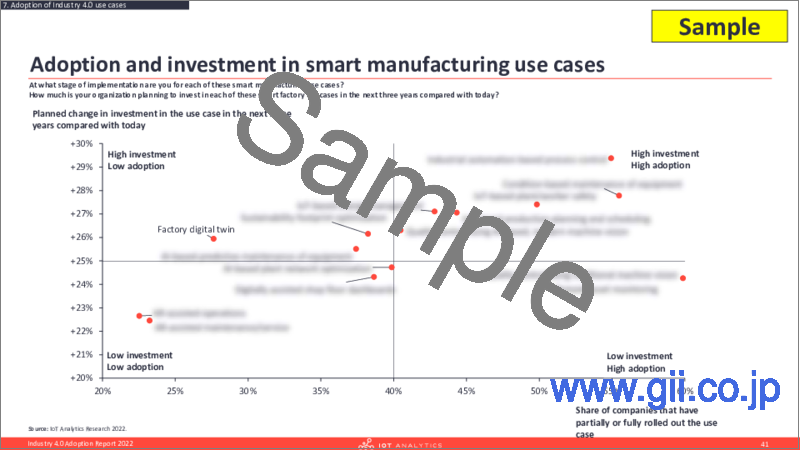|
|
市場調査レポート
商品コード
1132520
インダストリー4.0の導入分析 (2022年)Industry 4.0 Adoption Report 2022 |
||||||
| インダストリー4.0の導入分析 (2022年) |
|
出版日: 2022年10月07日
発行: IoT Analytics GmbH
ページ情報: 英文 217 Pages
納期: 即日から翌営業日
|
- 全表示
- 概要
- 目次
当レポートでは、世界の製造業におけるインダストリー4.0の導入状況について分析し、メーカー各社の上級管理職500名への聞き取り調査に基づいて、以下の項目について調査しております。
- スマートファクトリー戦略の導入状況、およびインダストリー4.0に関連する7つの戦略 (地域別・業種別)
- 調査回答者のKPI (主要業績評価指標) の重要性と改善計画 (KPIリスト27項目に基づく)
- 企業の意思決定者と整合性:フレームワーク別/企業連合別
- 投資の実行・計画状況:スマートマニュファクチャリング15社・コネクテッド製品16品目の利用事例 (地域別・業界別)
- スマートファクトリー・プロジェクトに参加しているベンダー
- 最大の技術的課題:調査回答者が直面した状況
- その他
当レポートは、IoTアナリティクスが継続的に行っている産業用IoTのカバレッジの一部です。本レポートに掲載されている情報は、製造業企業の上級管理職500人を対象とした広範な調査やアンケート調査に基づいています。
本書の目的は、IoT Analyticsの調査レンズを通して、製造業全体のインダストリー4.0使用事例の採用の現状を関係者に知らせることです。
当レポートで回答している質問
- メーカーにとって最も重要なスマートファクトリーのKPIは何か?
- オペレーションと製品で最も採用されているインダストリー4.0の利用事例は何か?
- インダストリー4.0プロジェクトにおける意思決定者は誰か?
- メーカーが概念実証 (PoC) から商業展開に移行するのを阻害しているスキルギャップには、どのようなものがあるか?
- メーカーはどのようにソフトウェアを調達し、それをどこにホストしているのか?
- 今後3年間、メーカーはどのようにソフトウェアを購入する予定なのか?
- 企業は主要なワークロードをどこで稼動させているか?
- どのような種類のベンダーが、インダストリー4.0プロジェクトに最も多く関与しているのか?
- 製造現場のセキュリティを確保するための、最も一般的な手法は何か?
- メーカーはコネクテッド製品のセキュリティをどのように保護しているのか?
概要
定義 (IoT Analyticsによる)
「最新のI4.0技術スタック要素(1)または特定のサポート技術(2)の使用により、メーカーはさまざまなデータソースの統合、より高いOEEの達成、コスト削減、または生産設定(商品製造、採掘、石油・ガス)に関連するその他のKPIの改善を行うことができ、主に新規または改良された使用事例の展開と連携しています。
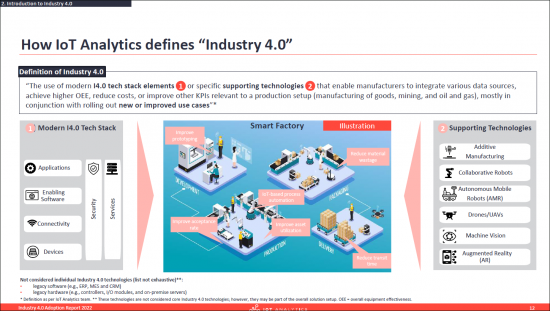
当レポートでは、以下の7つの観点からスマートファクトリー技術の導入状況を観察しています。
- 1. 戦略
- 2. KPI (主要業績評価指標)
- 3. 意思決定とフレームワーク
- 4. 利用事例の採用
- 5. クラウド・エッジへの展開
- 6. ベンダーの概略
- 7. 課題
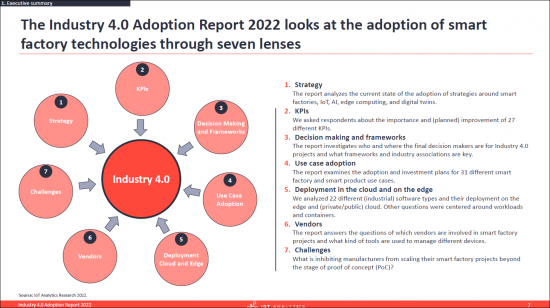
当レポートでは、地域、業界、企業規模を問わず、8種類の戦略の実施状況(theprogress)について統計を取っています。
また、スマートファクトリー戦略における各KPIの重要性を27のKPIリストで示しています。
最終意思決定者を意思決定タイプ別に詳細に分類しています。
スマート製造とコネクテッドプロダクトの使用事例について、地域や業界ごとの採用率や投資計画など、拡張された統計が含まれています。
IoT Analytics には、以下のそれぞれの導入と計画された投資に関する詳細な詳細が含まれます。
- スマート製造の使用事例15件
- 16のスマート製品使用事例
当レポートに掲載されている主な企業
|
|
目次
第1章 エグゼクティブサマリー
第2章 インダストリー4.0の概略
第3章 分析手法
第4章 インダストリー4.0の戦略
第5章 スマートファクトリーのKPI (主要業績評価指標)
第6章 意思決定とフレームワーク
第7章 インダストリー4.0の利用事例の採用
- a. 概要
- b. 詳細:スマートマニュファクチャリングの利用事例
- c. 詳細:スマート製品の利用事例/機能
第8章 展開方式 (クラウドとエッジ)
第9章 ベンダー
第10章 課題
第11章 付録
第12章 IoT Analyticsについて
217-page report on the state of Industry 4.0 adoption based on the input from 500 senior executives in manufacturing companies including:
- Implementation state of smart factory strategy and 7 more strategies related to industry 4.0 across different regions and industries
- Importance and planned improvement of respondents' KPIs across a list of 27 different KPIs
- The decision makers and alignment of companies with different frameworks/consortia
- Adoption and planned investment for 15 smart manufacturing and 16 connected products use cases across regions and industries
- Vendors involved in smart factory projects
- Biggest technical challenges faced by respondents
- And more
The “Industry 4.0 Adoption Report 2022” is part of IoT Analytics' ongoing coverage of industrial IoT. The information presented in this report is based on extensive research and an extensive survey of 500 senior executives in manufacturing companies.
The purpose of this document is to inform interested parties of the current state of adoption of Industry 4.0 use cases across manufacturers through the IoT Analytics research lens.
Questions answered in this report:
- What smart factory KPIs are most important to manufacturers?
- What are the most adopted Industry 4.0 use cases for operations and products?
- Who are the decision makers in Industry 4.0 projects?
- What are some of the skill gaps that inhibit manufacturers from moving from proof of concept (PoC) to commercial deployment?
- How do manufacturers procure software and where do they host it?
- How do manufacturers plan to purchase software in the next three years?
- Where do companies run key workloads?
- What kind of vendors are most often involved in Industry 4.0 projects?
- What are the most common techniques to secure the shop floor?
- How do manufacturers secure connected products?
At a glance:
Definition (as per IoT Analytics)
"The use of modern I4.0 tech stack elements (1) or specific supporting technologies (2) that enable manufacturers to integrate various data sources, achieve higher OEE, reduce costs, or improve other KPIs relevant to a production setup (manufacturing of goods, mining, and oil and gas), mostly in conjunction with rolling out new or improved use cases."

The Industry 4.0 Adoption Report 2022 looks at the adoption of smart factories technologies through seven lenses.
- 1. Strategy
- 2. KPIs
- 3. Decision makind and frameworks
- 4. Use case adoption
- 5. Deployment in the cloud and on the edge
- 6. Vendors
- 7. Challenges

This report includes statistics on the progress in the implementation of 8 different strategies across regions, industries, and company sizes.
The results show the importance each KPI has for the smart factory strategy across a list of 27 KPIs.
This publication includes a detailed breakdown of the final decision makers by decision type.
This report includes extended statistics for smart manufacturing and connected products use cases, including adoption rate and planned investments across regions and industries.
IoT Analytics includes detailed deep dives into the adoption and planned investment for each of the:
- 15 smart manufacturing use cases
- 16 smart product use cases
Selected companies mentioned in the report:
|
|
Table of Contents
1. Executive summary
2. Introduction to Industry 4.0
3. Methodology
4. Industry 4.0 strategy
5. Smart factory KPIs
6. Decision making and frameworks
7. Adoption of Industry 4.0 use cases
- a. Overview
- b. Deep dive: Smart manufacturing use cases
- c. Deep dive: Smart product use cases/features
